MBA641 Feasibility Study: Residential Duplex Development Project
VerifiedAdded on 2023/06/07
|11
|3324
|447
Case Study
AI Summary
This document presents a feasibility study for a residential duplex development project in New South Wales (NSW), Australia, undertaken as part of the Strategic Project Management MBA641 course. The study assesses the project's goals, constraints, and macro and micro environmental drivers, including economic, competitive, resource, demographic, technical, managerial, cultural, social, safety, time pressure, and political feasibility. The analysis considers the project's objective of providing affordable housing within a nine-month timeframe and a budget of $800,000. It explores the importance of understanding market needs, resource requirements, and demographic factors, alongside technical, managerial, and social considerations, to mitigate risks and ensure project success. The study emphasizes the need for community participation and a comprehensive understanding of the project's impact on the surrounding environment. The document is contributed by a student and available on Desklib, a platform offering study tools for students.
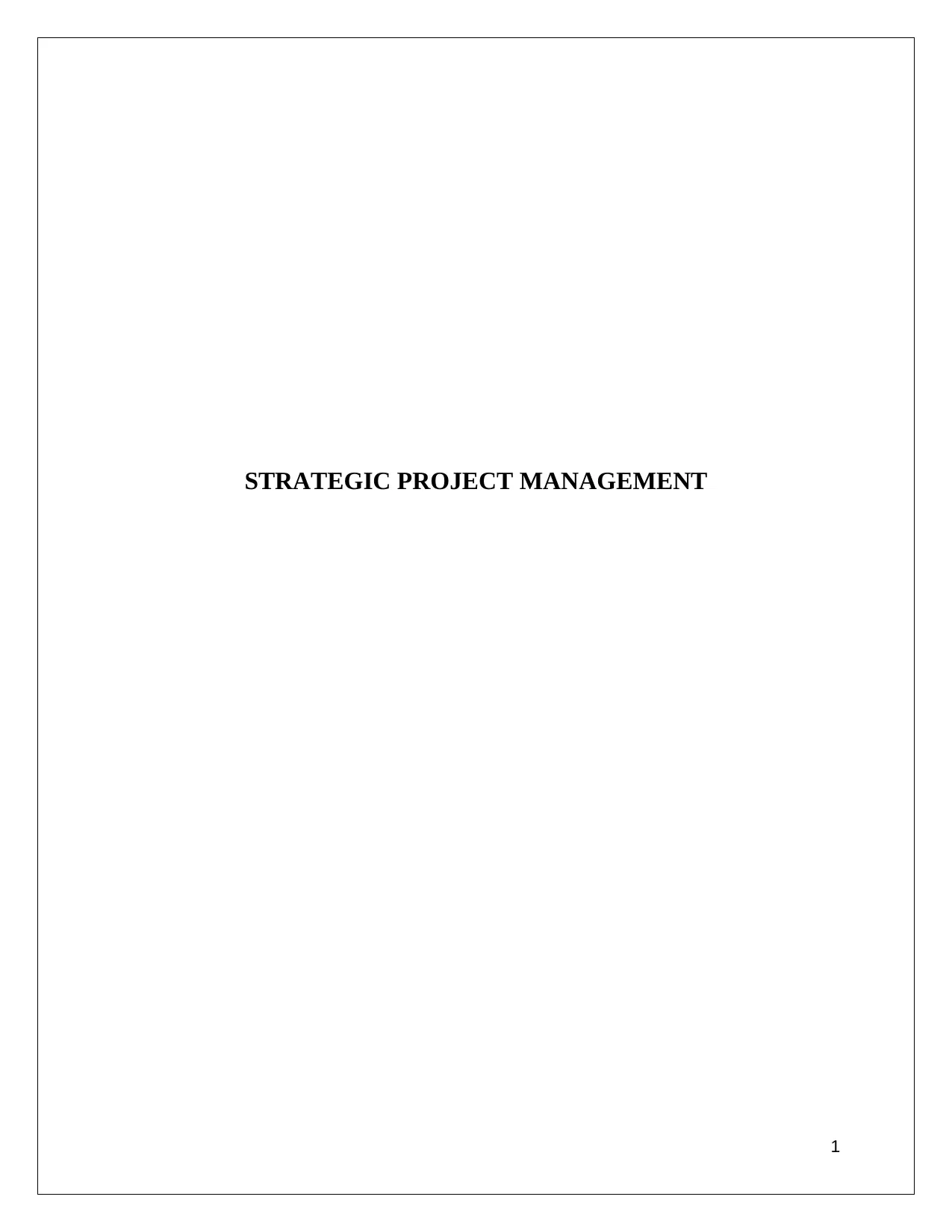
STRATEGIC PROJECT MANAGEMENT
1
1
Paraphrase This Document
Need a fresh take? Get an instant paraphrase of this document with our AI Paraphraser
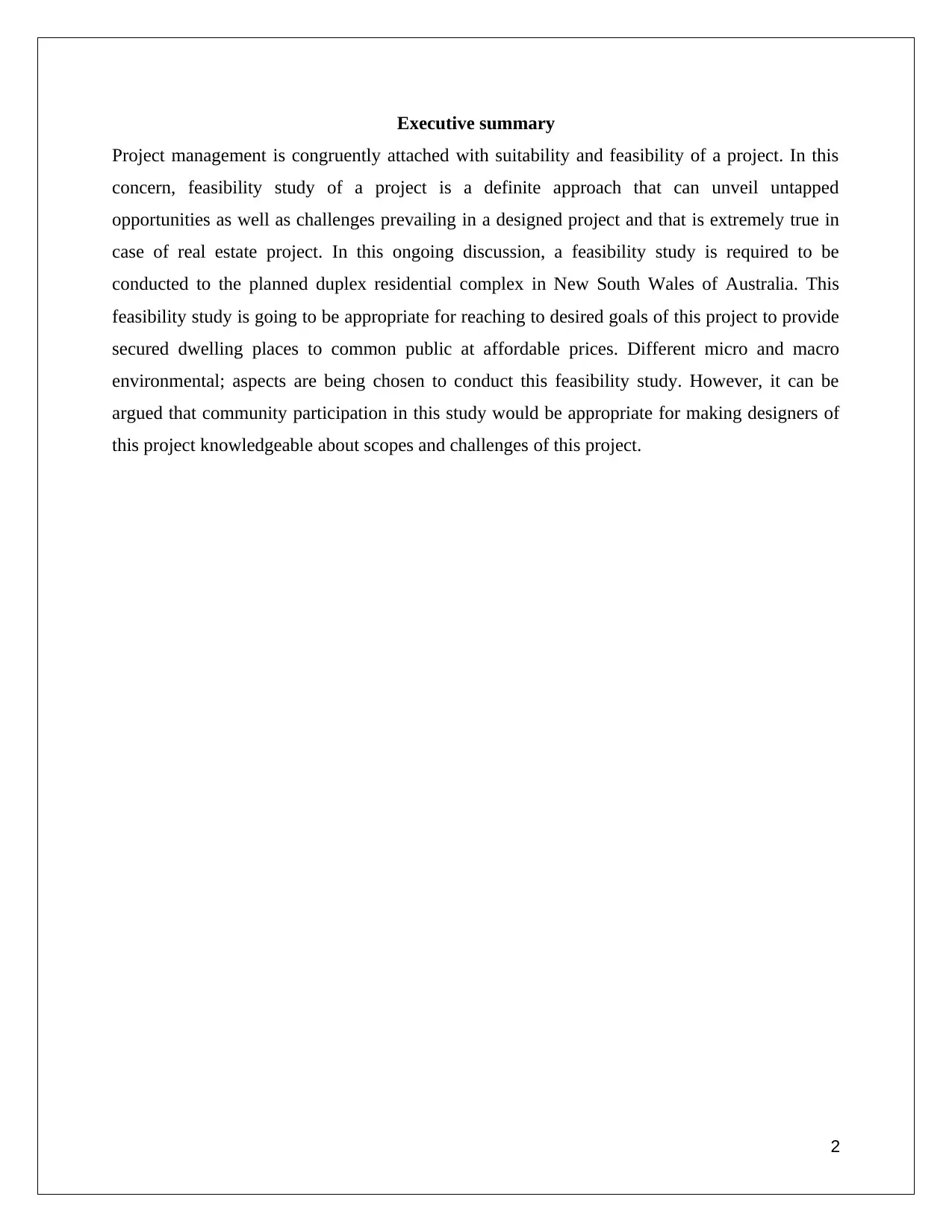
Executive summary
Project management is congruently attached with suitability and feasibility of a project. In this
concern, feasibility study of a project is a definite approach that can unveil untapped
opportunities as well as challenges prevailing in a designed project and that is extremely true in
case of real estate project. In this ongoing discussion, a feasibility study is required to be
conducted to the planned duplex residential complex in New South Wales of Australia. This
feasibility study is going to be appropriate for reaching to desired goals of this project to provide
secured dwelling places to common public at affordable prices. Different micro and macro
environmental; aspects are being chosen to conduct this feasibility study. However, it can be
argued that community participation in this study would be appropriate for making designers of
this project knowledgeable about scopes and challenges of this project.
2
Project management is congruently attached with suitability and feasibility of a project. In this
concern, feasibility study of a project is a definite approach that can unveil untapped
opportunities as well as challenges prevailing in a designed project and that is extremely true in
case of real estate project. In this ongoing discussion, a feasibility study is required to be
conducted to the planned duplex residential complex in New South Wales of Australia. This
feasibility study is going to be appropriate for reaching to desired goals of this project to provide
secured dwelling places to common public at affordable prices. Different micro and macro
environmental; aspects are being chosen to conduct this feasibility study. However, it can be
argued that community participation in this study would be appropriate for making designers of
this project knowledgeable about scopes and challenges of this project.
2
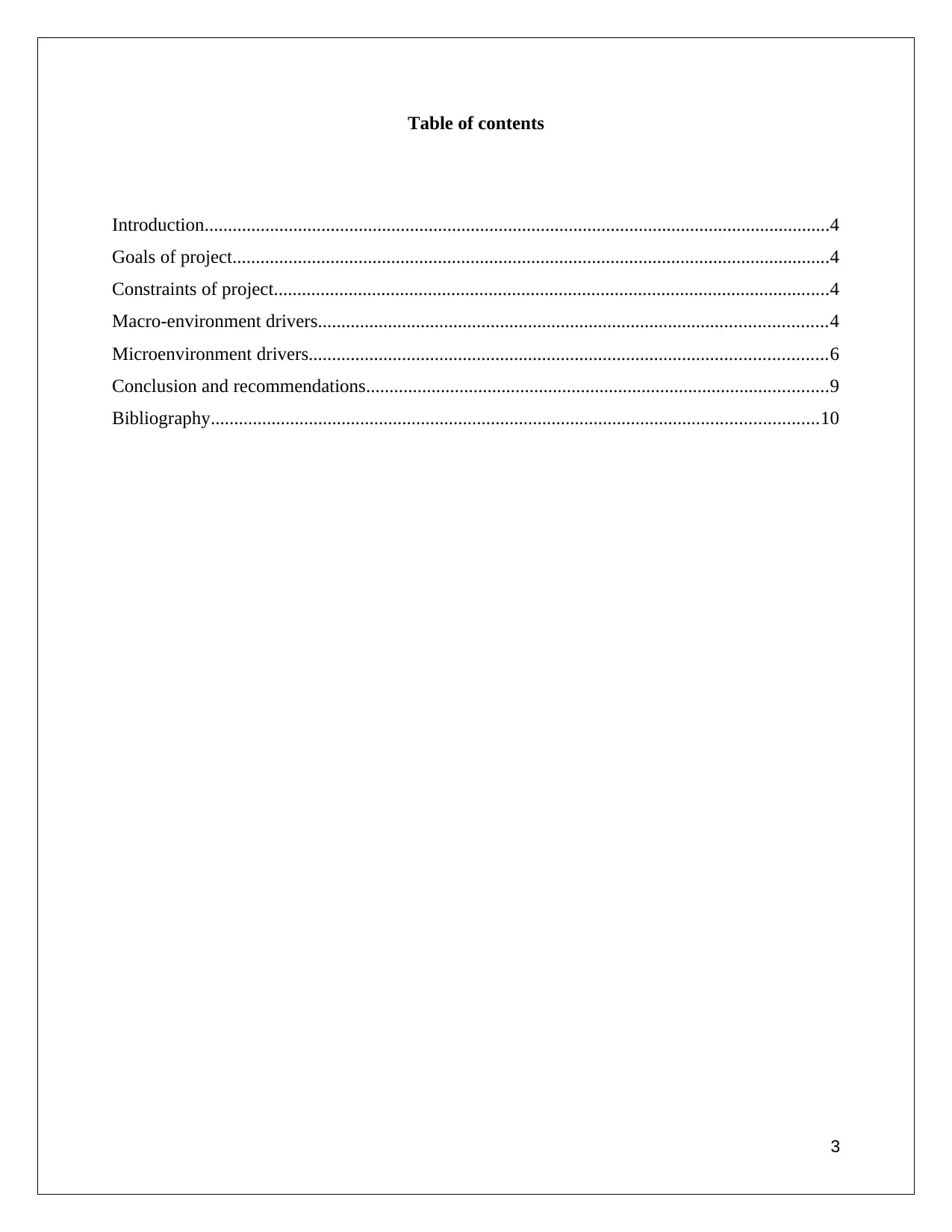
Table of contents
Introduction......................................................................................................................................4
Goals of project................................................................................................................................4
Constraints of project.......................................................................................................................4
Macro-environment drivers.............................................................................................................4
Microenvironment drivers...............................................................................................................6
Conclusion and recommendations...................................................................................................9
Bibliography..................................................................................................................................10
3
Introduction......................................................................................................................................4
Goals of project................................................................................................................................4
Constraints of project.......................................................................................................................4
Macro-environment drivers.............................................................................................................4
Microenvironment drivers...............................................................................................................6
Conclusion and recommendations...................................................................................................9
Bibliography..................................................................................................................................10
3
⊘ This is a preview!⊘
Do you want full access?
Subscribe today to unlock all pages.

Trusted by 1+ million students worldwide
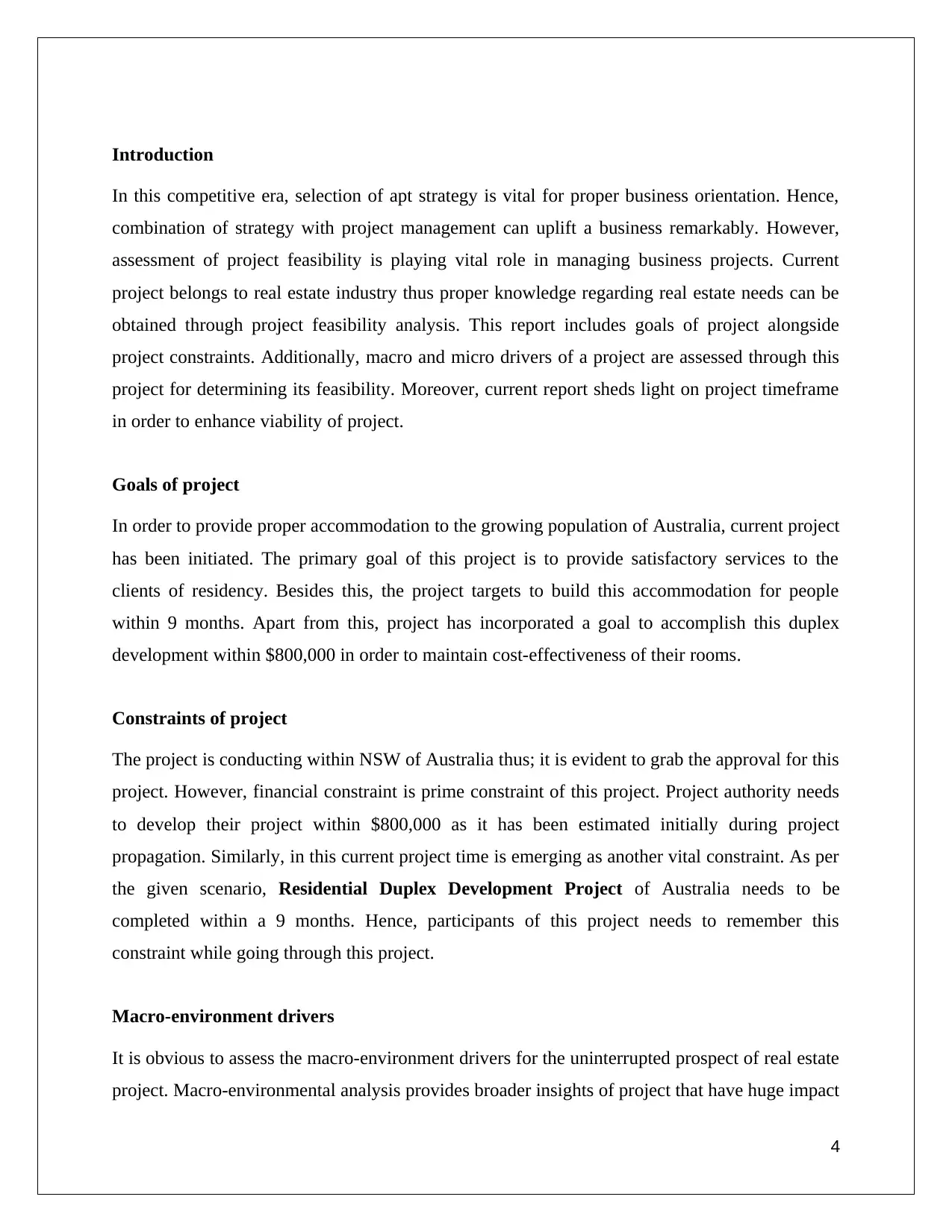
Introduction
In this competitive era, selection of apt strategy is vital for proper business orientation. Hence,
combination of strategy with project management can uplift a business remarkably. However,
assessment of project feasibility is playing vital role in managing business projects. Current
project belongs to real estate industry thus proper knowledge regarding real estate needs can be
obtained through project feasibility analysis. This report includes goals of project alongside
project constraints. Additionally, macro and micro drivers of a project are assessed through this
project for determining its feasibility. Moreover, current report sheds light on project timeframe
in order to enhance viability of project.
Goals of project
In order to provide proper accommodation to the growing population of Australia, current project
has been initiated. The primary goal of this project is to provide satisfactory services to the
clients of residency. Besides this, the project targets to build this accommodation for people
within 9 months. Apart from this, project has incorporated a goal to accomplish this duplex
development within $800,000 in order to maintain cost-effectiveness of their rooms.
Constraints of project
The project is conducting within NSW of Australia thus; it is evident to grab the approval for this
project. However, financial constraint is prime constraint of this project. Project authority needs
to develop their project within $800,000 as it has been estimated initially during project
propagation. Similarly, in this current project time is emerging as another vital constraint. As per
the given scenario, Residential Duplex Development Project of Australia needs to be
completed within a 9 months. Hence, participants of this project needs to remember this
constraint while going through this project.
Macro-environment drivers
It is obvious to assess the macro-environment drivers for the uninterrupted prospect of real estate
project. Macro-environmental analysis provides broader insights of project that have huge impact
4
In this competitive era, selection of apt strategy is vital for proper business orientation. Hence,
combination of strategy with project management can uplift a business remarkably. However,
assessment of project feasibility is playing vital role in managing business projects. Current
project belongs to real estate industry thus proper knowledge regarding real estate needs can be
obtained through project feasibility analysis. This report includes goals of project alongside
project constraints. Additionally, macro and micro drivers of a project are assessed through this
project for determining its feasibility. Moreover, current report sheds light on project timeframe
in order to enhance viability of project.
Goals of project
In order to provide proper accommodation to the growing population of Australia, current project
has been initiated. The primary goal of this project is to provide satisfactory services to the
clients of residency. Besides this, the project targets to build this accommodation for people
within 9 months. Apart from this, project has incorporated a goal to accomplish this duplex
development within $800,000 in order to maintain cost-effectiveness of their rooms.
Constraints of project
The project is conducting within NSW of Australia thus; it is evident to grab the approval for this
project. However, financial constraint is prime constraint of this project. Project authority needs
to develop their project within $800,000 as it has been estimated initially during project
propagation. Similarly, in this current project time is emerging as another vital constraint. As per
the given scenario, Residential Duplex Development Project of Australia needs to be
completed within a 9 months. Hence, participants of this project needs to remember this
constraint while going through this project.
Macro-environment drivers
It is obvious to assess the macro-environment drivers for the uninterrupted prospect of real estate
project. Macro-environmental analysis provides broader insights of project that have huge impact
4
Paraphrase This Document
Need a fresh take? Get an instant paraphrase of this document with our AI Paraphraser
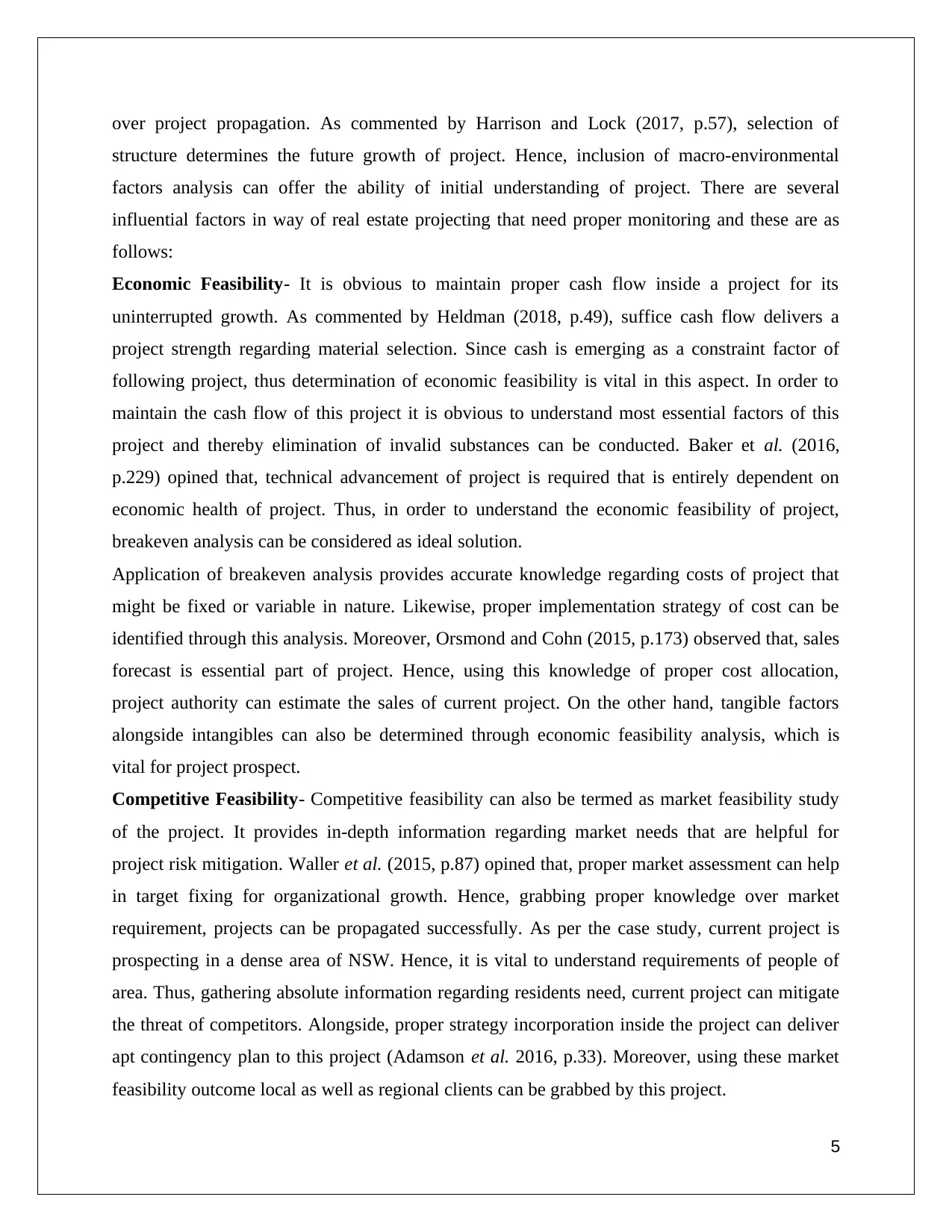
over project propagation. As commented by Harrison and Lock (2017, p.57), selection of
structure determines the future growth of project. Hence, inclusion of macro-environmental
factors analysis can offer the ability of initial understanding of project. There are several
influential factors in way of real estate projecting that need proper monitoring and these are as
follows:
Economic Feasibility- It is obvious to maintain proper cash flow inside a project for its
uninterrupted growth. As commented by Heldman (2018, p.49), suffice cash flow delivers a
project strength regarding material selection. Since cash is emerging as a constraint factor of
following project, thus determination of economic feasibility is vital in this aspect. In order to
maintain the cash flow of this project it is obvious to understand most essential factors of this
project and thereby elimination of invalid substances can be conducted. Baker et al. (2016,
p.229) opined that, technical advancement of project is required that is entirely dependent on
economic health of project. Thus, in order to understand the economic feasibility of project,
breakeven analysis can be considered as ideal solution.
Application of breakeven analysis provides accurate knowledge regarding costs of project that
might be fixed or variable in nature. Likewise, proper implementation strategy of cost can be
identified through this analysis. Moreover, Orsmond and Cohn (2015, p.173) observed that, sales
forecast is essential part of project. Hence, using this knowledge of proper cost allocation,
project authority can estimate the sales of current project. On the other hand, tangible factors
alongside intangibles can also be determined through economic feasibility analysis, which is
vital for project prospect.
Competitive Feasibility- Competitive feasibility can also be termed as market feasibility study
of the project. It provides in-depth information regarding market needs that are helpful for
project risk mitigation. Waller et al. (2015, p.87) opined that, proper market assessment can help
in target fixing for organizational growth. Hence, grabbing proper knowledge over market
requirement, projects can be propagated successfully. As per the case study, current project is
prospecting in a dense area of NSW. Hence, it is vital to understand requirements of people of
area. Thus, gathering absolute information regarding residents need, current project can mitigate
the threat of competitors. Alongside, proper strategy incorporation inside the project can deliver
apt contingency plan to this project (Adamson et al. 2016, p.33). Moreover, using these market
feasibility outcome local as well as regional clients can be grabbed by this project.
5
structure determines the future growth of project. Hence, inclusion of macro-environmental
factors analysis can offer the ability of initial understanding of project. There are several
influential factors in way of real estate projecting that need proper monitoring and these are as
follows:
Economic Feasibility- It is obvious to maintain proper cash flow inside a project for its
uninterrupted growth. As commented by Heldman (2018, p.49), suffice cash flow delivers a
project strength regarding material selection. Since cash is emerging as a constraint factor of
following project, thus determination of economic feasibility is vital in this aspect. In order to
maintain the cash flow of this project it is obvious to understand most essential factors of this
project and thereby elimination of invalid substances can be conducted. Baker et al. (2016,
p.229) opined that, technical advancement of project is required that is entirely dependent on
economic health of project. Thus, in order to understand the economic feasibility of project,
breakeven analysis can be considered as ideal solution.
Application of breakeven analysis provides accurate knowledge regarding costs of project that
might be fixed or variable in nature. Likewise, proper implementation strategy of cost can be
identified through this analysis. Moreover, Orsmond and Cohn (2015, p.173) observed that, sales
forecast is essential part of project. Hence, using this knowledge of proper cost allocation,
project authority can estimate the sales of current project. On the other hand, tangible factors
alongside intangibles can also be determined through economic feasibility analysis, which is
vital for project prospect.
Competitive Feasibility- Competitive feasibility can also be termed as market feasibility study
of the project. It provides in-depth information regarding market needs that are helpful for
project risk mitigation. Waller et al. (2015, p.87) opined that, proper market assessment can help
in target fixing for organizational growth. Hence, grabbing proper knowledge over market
requirement, projects can be propagated successfully. As per the case study, current project is
prospecting in a dense area of NSW. Hence, it is vital to understand requirements of people of
area. Thus, gathering absolute information regarding residents need, current project can mitigate
the threat of competitors. Alongside, proper strategy incorporation inside the project can deliver
apt contingency plan to this project (Adamson et al. 2016, p.33). Moreover, using these market
feasibility outcome local as well as regional clients can be grabbed by this project.
5
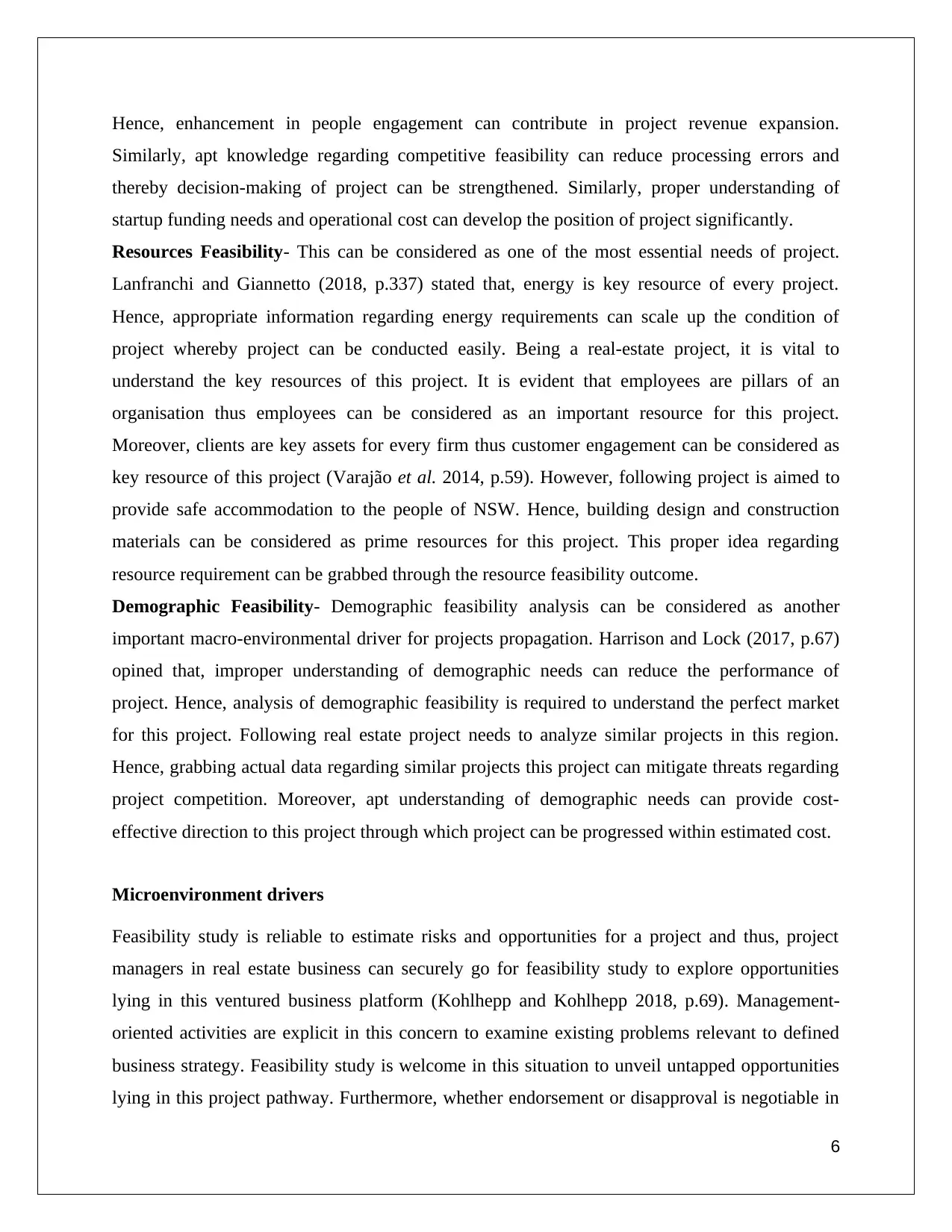
Hence, enhancement in people engagement can contribute in project revenue expansion.
Similarly, apt knowledge regarding competitive feasibility can reduce processing errors and
thereby decision-making of project can be strengthened. Similarly, proper understanding of
startup funding needs and operational cost can develop the position of project significantly.
Resources Feasibility- This can be considered as one of the most essential needs of project.
Lanfranchi and Giannetto (2018, p.337) stated that, energy is key resource of every project.
Hence, appropriate information regarding energy requirements can scale up the condition of
project whereby project can be conducted easily. Being a real-estate project, it is vital to
understand the key resources of this project. It is evident that employees are pillars of an
organisation thus employees can be considered as an important resource for this project.
Moreover, clients are key assets for every firm thus customer engagement can be considered as
key resource of this project (Varajão et al. 2014, p.59). However, following project is aimed to
provide safe accommodation to the people of NSW. Hence, building design and construction
materials can be considered as prime resources for this project. This proper idea regarding
resource requirement can be grabbed through the resource feasibility outcome.
Demographic Feasibility- Demographic feasibility analysis can be considered as another
important macro-environmental driver for projects propagation. Harrison and Lock (2017, p.67)
opined that, improper understanding of demographic needs can reduce the performance of
project. Hence, analysis of demographic feasibility is required to understand the perfect market
for this project. Following real estate project needs to analyze similar projects in this region.
Hence, grabbing actual data regarding similar projects this project can mitigate threats regarding
project competition. Moreover, apt understanding of demographic needs can provide cost-
effective direction to this project through which project can be progressed within estimated cost.
Microenvironment drivers
Feasibility study is reliable to estimate risks and opportunities for a project and thus, project
managers in real estate business can securely go for feasibility study to explore opportunities
lying in this ventured business platform (Kohlhepp and Kohlhepp 2018, p.69). Management-
oriented activities are explicit in this concern to examine existing problems relevant to defined
business strategy. Feasibility study is welcome in this situation to unveil untapped opportunities
lying in this project pathway. Furthermore, whether endorsement or disapproval is negotiable in
6
Similarly, apt knowledge regarding competitive feasibility can reduce processing errors and
thereby decision-making of project can be strengthened. Similarly, proper understanding of
startup funding needs and operational cost can develop the position of project significantly.
Resources Feasibility- This can be considered as one of the most essential needs of project.
Lanfranchi and Giannetto (2018, p.337) stated that, energy is key resource of every project.
Hence, appropriate information regarding energy requirements can scale up the condition of
project whereby project can be conducted easily. Being a real-estate project, it is vital to
understand the key resources of this project. It is evident that employees are pillars of an
organisation thus employees can be considered as an important resource for this project.
Moreover, clients are key assets for every firm thus customer engagement can be considered as
key resource of this project (Varajão et al. 2014, p.59). However, following project is aimed to
provide safe accommodation to the people of NSW. Hence, building design and construction
materials can be considered as prime resources for this project. This proper idea regarding
resource requirement can be grabbed through the resource feasibility outcome.
Demographic Feasibility- Demographic feasibility analysis can be considered as another
important macro-environmental driver for projects propagation. Harrison and Lock (2017, p.67)
opined that, improper understanding of demographic needs can reduce the performance of
project. Hence, analysis of demographic feasibility is required to understand the perfect market
for this project. Following real estate project needs to analyze similar projects in this region.
Hence, grabbing actual data regarding similar projects this project can mitigate threats regarding
project competition. Moreover, apt understanding of demographic needs can provide cost-
effective direction to this project through which project can be progressed within estimated cost.
Microenvironment drivers
Feasibility study is reliable to estimate risks and opportunities for a project and thus, project
managers in real estate business can securely go for feasibility study to explore opportunities
lying in this ventured business platform (Kohlhepp and Kohlhepp 2018, p.69). Management-
oriented activities are explicit in this concern to examine existing problems relevant to defined
business strategy. Feasibility study is welcome in this situation to unveil untapped opportunities
lying in this project pathway. Furthermore, whether endorsement or disapproval is negotiable in
6
⊘ This is a preview!⊘
Do you want full access?
Subscribe today to unlock all pages.

Trusted by 1+ million students worldwide
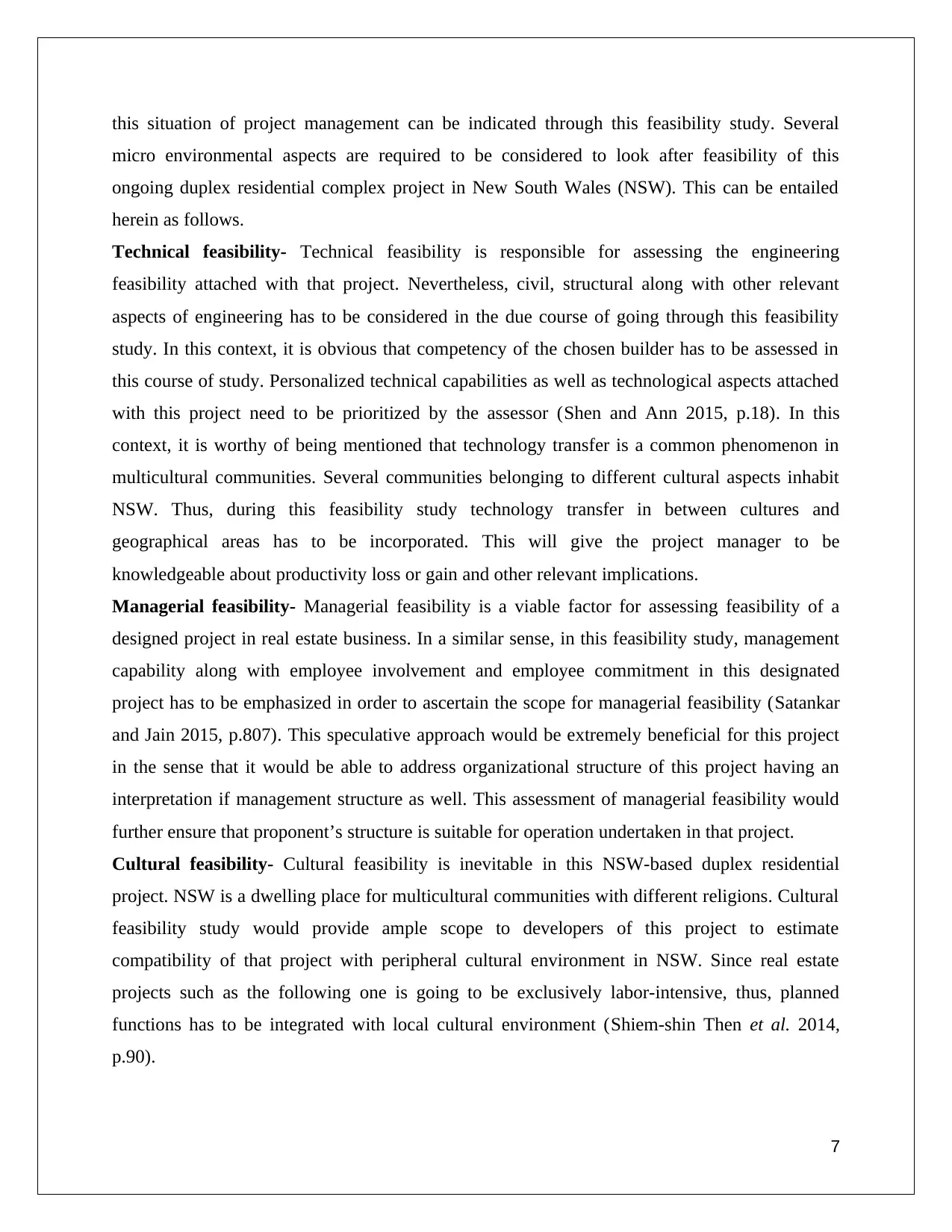
this situation of project management can be indicated through this feasibility study. Several
micro environmental aspects are required to be considered to look after feasibility of this
ongoing duplex residential complex project in New South Wales (NSW). This can be entailed
herein as follows.
Technical feasibility- Technical feasibility is responsible for assessing the engineering
feasibility attached with that project. Nevertheless, civil, structural along with other relevant
aspects of engineering has to be considered in the due course of going through this feasibility
study. In this context, it is obvious that competency of the chosen builder has to be assessed in
this course of study. Personalized technical capabilities as well as technological aspects attached
with this project need to be prioritized by the assessor (Shen and Ann 2015, p.18). In this
context, it is worthy of being mentioned that technology transfer is a common phenomenon in
multicultural communities. Several communities belonging to different cultural aspects inhabit
NSW. Thus, during this feasibility study technology transfer in between cultures and
geographical areas has to be incorporated. This will give the project manager to be
knowledgeable about productivity loss or gain and other relevant implications.
Managerial feasibility- Managerial feasibility is a viable factor for assessing feasibility of a
designed project in real estate business. In a similar sense, in this feasibility study, management
capability along with employee involvement and employee commitment in this designated
project has to be emphasized in order to ascertain the scope for managerial feasibility (Satankar
and Jain 2015, p.807). This speculative approach would be extremely beneficial for this project
in the sense that it would be able to address organizational structure of this project having an
interpretation if management structure as well. This assessment of managerial feasibility would
further ensure that proponent’s structure is suitable for operation undertaken in that project.
Cultural feasibility- Cultural feasibility is inevitable in this NSW-based duplex residential
project. NSW is a dwelling place for multicultural communities with different religions. Cultural
feasibility study would provide ample scope to developers of this project to estimate
compatibility of that project with peripheral cultural environment in NSW. Since real estate
projects such as the following one is going to be exclusively labor-intensive, thus, planned
functions has to be integrated with local cultural environment (Shiem-shin Then et al. 2014,
p.90).
7
micro environmental aspects are required to be considered to look after feasibility of this
ongoing duplex residential complex project in New South Wales (NSW). This can be entailed
herein as follows.
Technical feasibility- Technical feasibility is responsible for assessing the engineering
feasibility attached with that project. Nevertheless, civil, structural along with other relevant
aspects of engineering has to be considered in the due course of going through this feasibility
study. In this context, it is obvious that competency of the chosen builder has to be assessed in
this course of study. Personalized technical capabilities as well as technological aspects attached
with this project need to be prioritized by the assessor (Shen and Ann 2015, p.18). In this
context, it is worthy of being mentioned that technology transfer is a common phenomenon in
multicultural communities. Several communities belonging to different cultural aspects inhabit
NSW. Thus, during this feasibility study technology transfer in between cultures and
geographical areas has to be incorporated. This will give the project manager to be
knowledgeable about productivity loss or gain and other relevant implications.
Managerial feasibility- Managerial feasibility is a viable factor for assessing feasibility of a
designed project in real estate business. In a similar sense, in this feasibility study, management
capability along with employee involvement and employee commitment in this designated
project has to be emphasized in order to ascertain the scope for managerial feasibility (Satankar
and Jain 2015, p.807). This speculative approach would be extremely beneficial for this project
in the sense that it would be able to address organizational structure of this project having an
interpretation if management structure as well. This assessment of managerial feasibility would
further ensure that proponent’s structure is suitable for operation undertaken in that project.
Cultural feasibility- Cultural feasibility is inevitable in this NSW-based duplex residential
project. NSW is a dwelling place for multicultural communities with different religions. Cultural
feasibility study would provide ample scope to developers of this project to estimate
compatibility of that project with peripheral cultural environment in NSW. Since real estate
projects such as the following one is going to be exclusively labor-intensive, thus, planned
functions has to be integrated with local cultural environment (Shiem-shin Then et al. 2014,
p.90).
7
Paraphrase This Document
Need a fresh take? Get an instant paraphrase of this document with our AI Paraphraser
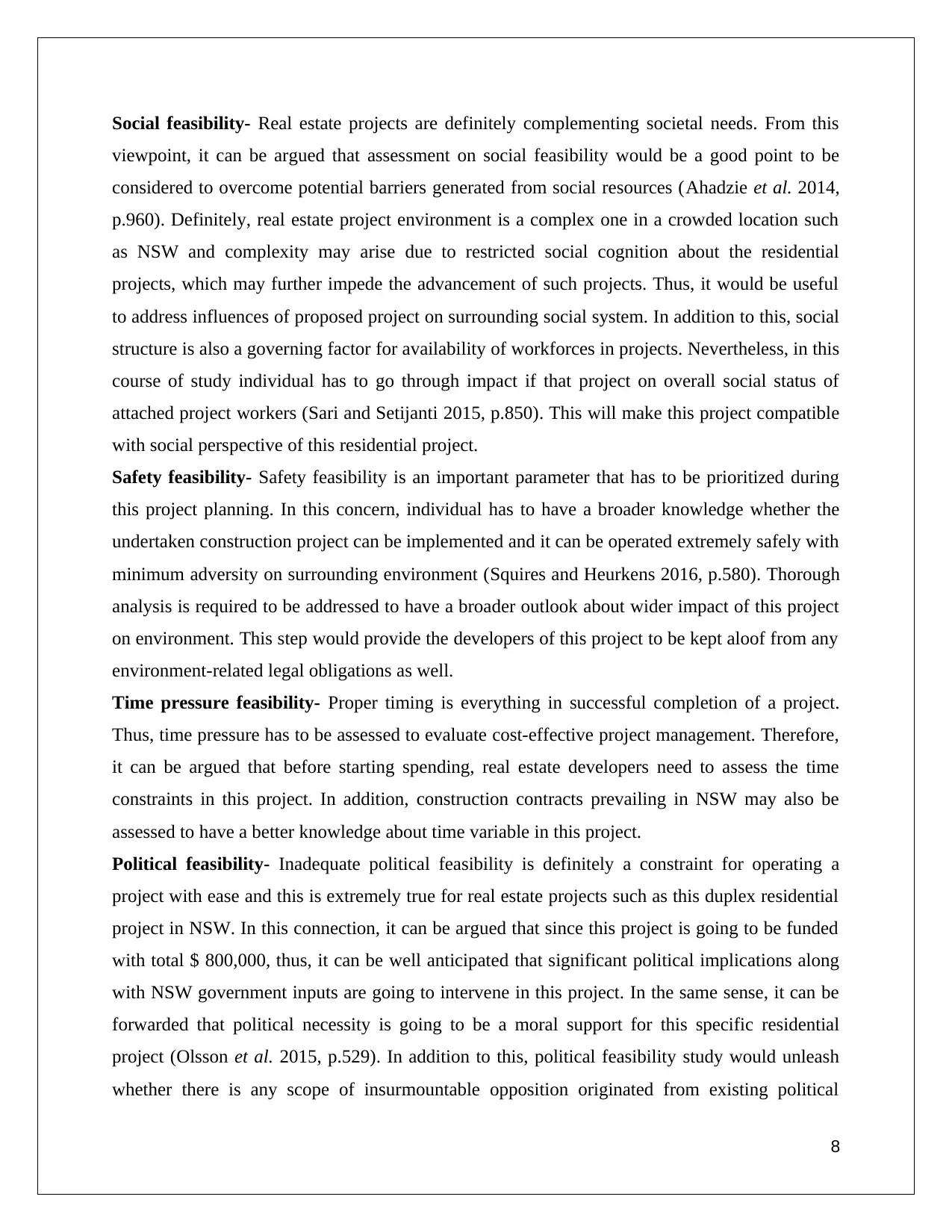
Social feasibility- Real estate projects are definitely complementing societal needs. From this
viewpoint, it can be argued that assessment on social feasibility would be a good point to be
considered to overcome potential barriers generated from social resources (Ahadzie et al. 2014,
p.960). Definitely, real estate project environment is a complex one in a crowded location such
as NSW and complexity may arise due to restricted social cognition about the residential
projects, which may further impede the advancement of such projects. Thus, it would be useful
to address influences of proposed project on surrounding social system. In addition to this, social
structure is also a governing factor for availability of workforces in projects. Nevertheless, in this
course of study individual has to go through impact if that project on overall social status of
attached project workers (Sari and Setijanti 2015, p.850). This will make this project compatible
with social perspective of this residential project.
Safety feasibility- Safety feasibility is an important parameter that has to be prioritized during
this project planning. In this concern, individual has to have a broader knowledge whether the
undertaken construction project can be implemented and it can be operated extremely safely with
minimum adversity on surrounding environment (Squires and Heurkens 2016, p.580). Thorough
analysis is required to be addressed to have a broader outlook about wider impact of this project
on environment. This step would provide the developers of this project to be kept aloof from any
environment-related legal obligations as well.
Time pressure feasibility- Proper timing is everything in successful completion of a project.
Thus, time pressure has to be assessed to evaluate cost-effective project management. Therefore,
it can be argued that before starting spending, real estate developers need to assess the time
constraints in this project. In addition, construction contracts prevailing in NSW may also be
assessed to have a better knowledge about time variable in this project.
Political feasibility- Inadequate political feasibility is definitely a constraint for operating a
project with ease and this is extremely true for real estate projects such as this duplex residential
project in NSW. In this connection, it can be argued that since this project is going to be funded
with total $ 800,000, thus, it can be well anticipated that significant political implications along
with NSW government inputs are going to intervene in this project. In the same sense, it can be
forwarded that political necessity is going to be a moral support for this specific residential
project (Olsson et al. 2015, p.529). In addition to this, political feasibility study would unleash
whether there is any scope of insurmountable opposition originated from existing political
8
viewpoint, it can be argued that assessment on social feasibility would be a good point to be
considered to overcome potential barriers generated from social resources (Ahadzie et al. 2014,
p.960). Definitely, real estate project environment is a complex one in a crowded location such
as NSW and complexity may arise due to restricted social cognition about the residential
projects, which may further impede the advancement of such projects. Thus, it would be useful
to address influences of proposed project on surrounding social system. In addition to this, social
structure is also a governing factor for availability of workforces in projects. Nevertheless, in this
course of study individual has to go through impact if that project on overall social status of
attached project workers (Sari and Setijanti 2015, p.850). This will make this project compatible
with social perspective of this residential project.
Safety feasibility- Safety feasibility is an important parameter that has to be prioritized during
this project planning. In this concern, individual has to have a broader knowledge whether the
undertaken construction project can be implemented and it can be operated extremely safely with
minimum adversity on surrounding environment (Squires and Heurkens 2016, p.580). Thorough
analysis is required to be addressed to have a broader outlook about wider impact of this project
on environment. This step would provide the developers of this project to be kept aloof from any
environment-related legal obligations as well.
Time pressure feasibility- Proper timing is everything in successful completion of a project.
Thus, time pressure has to be assessed to evaluate cost-effective project management. Therefore,
it can be argued that before starting spending, real estate developers need to assess the time
constraints in this project. In addition, construction contracts prevailing in NSW may also be
assessed to have a better knowledge about time variable in this project.
Political feasibility- Inadequate political feasibility is definitely a constraint for operating a
project with ease and this is extremely true for real estate projects such as this duplex residential
project in NSW. In this connection, it can be argued that since this project is going to be funded
with total $ 800,000, thus, it can be well anticipated that significant political implications along
with NSW government inputs are going to intervene in this project. In the same sense, it can be
forwarded that political necessity is going to be a moral support for this specific residential
project (Olsson et al. 2015, p.529). In addition to this, political feasibility study would unleash
whether there is any scope of insurmountable opposition originated from existing political
8
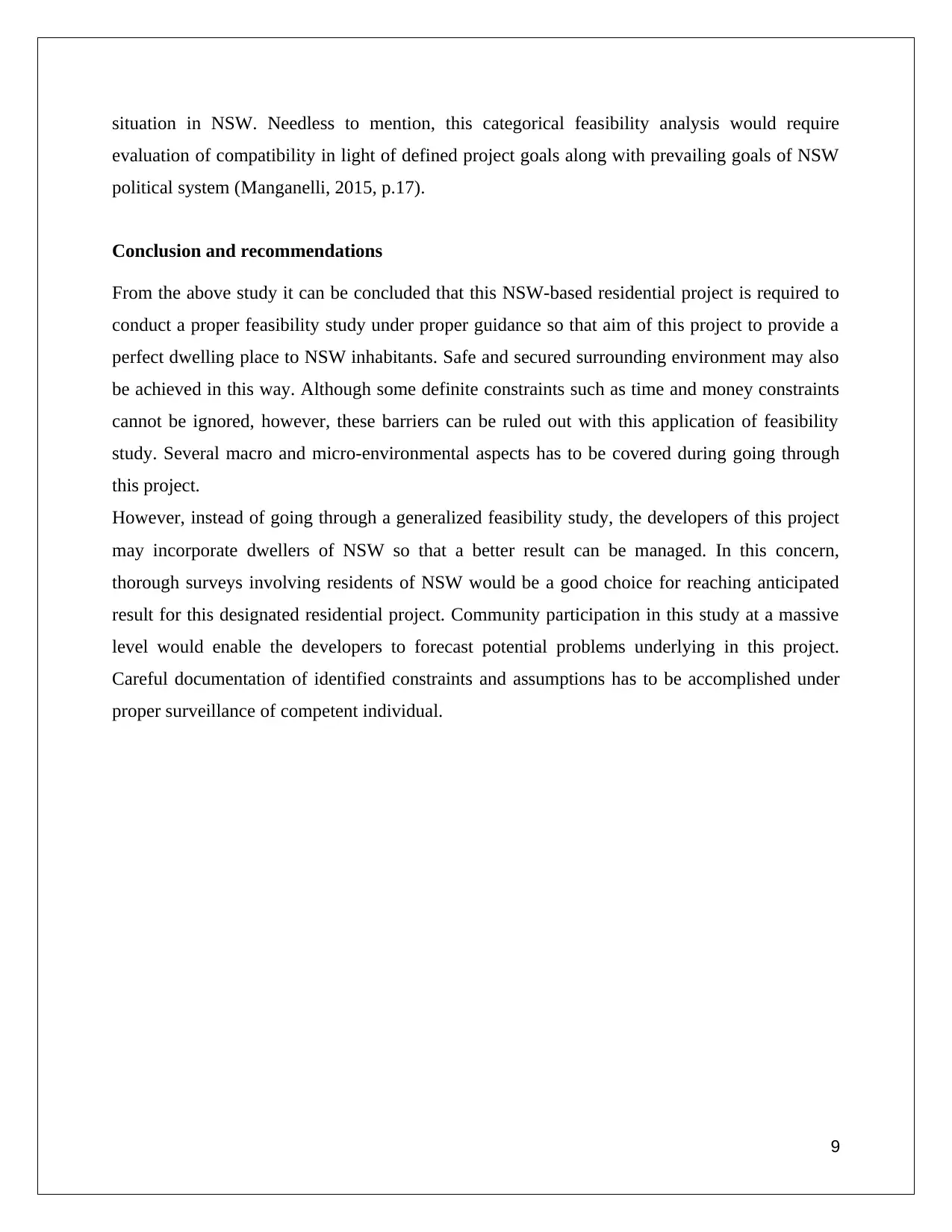
situation in NSW. Needless to mention, this categorical feasibility analysis would require
evaluation of compatibility in light of defined project goals along with prevailing goals of NSW
political system (Manganelli, 2015, p.17).
Conclusion and recommendations
From the above study it can be concluded that this NSW-based residential project is required to
conduct a proper feasibility study under proper guidance so that aim of this project to provide a
perfect dwelling place to NSW inhabitants. Safe and secured surrounding environment may also
be achieved in this way. Although some definite constraints such as time and money constraints
cannot be ignored, however, these barriers can be ruled out with this application of feasibility
study. Several macro and micro-environmental aspects has to be covered during going through
this project.
However, instead of going through a generalized feasibility study, the developers of this project
may incorporate dwellers of NSW so that a better result can be managed. In this concern,
thorough surveys involving residents of NSW would be a good choice for reaching anticipated
result for this designated residential project. Community participation in this study at a massive
level would enable the developers to forecast potential problems underlying in this project.
Careful documentation of identified constraints and assumptions has to be accomplished under
proper surveillance of competent individual.
9
evaluation of compatibility in light of defined project goals along with prevailing goals of NSW
political system (Manganelli, 2015, p.17).
Conclusion and recommendations
From the above study it can be concluded that this NSW-based residential project is required to
conduct a proper feasibility study under proper guidance so that aim of this project to provide a
perfect dwelling place to NSW inhabitants. Safe and secured surrounding environment may also
be achieved in this way. Although some definite constraints such as time and money constraints
cannot be ignored, however, these barriers can be ruled out with this application of feasibility
study. Several macro and micro-environmental aspects has to be covered during going through
this project.
However, instead of going through a generalized feasibility study, the developers of this project
may incorporate dwellers of NSW so that a better result can be managed. In this concern,
thorough surveys involving residents of NSW would be a good choice for reaching anticipated
result for this designated residential project. Community participation in this study at a massive
level would enable the developers to forecast potential problems underlying in this project.
Careful documentation of identified constraints and assumptions has to be accomplished under
proper surveillance of competent individual.
9
⊘ This is a preview!⊘
Do you want full access?
Subscribe today to unlock all pages.

Trusted by 1+ million students worldwide
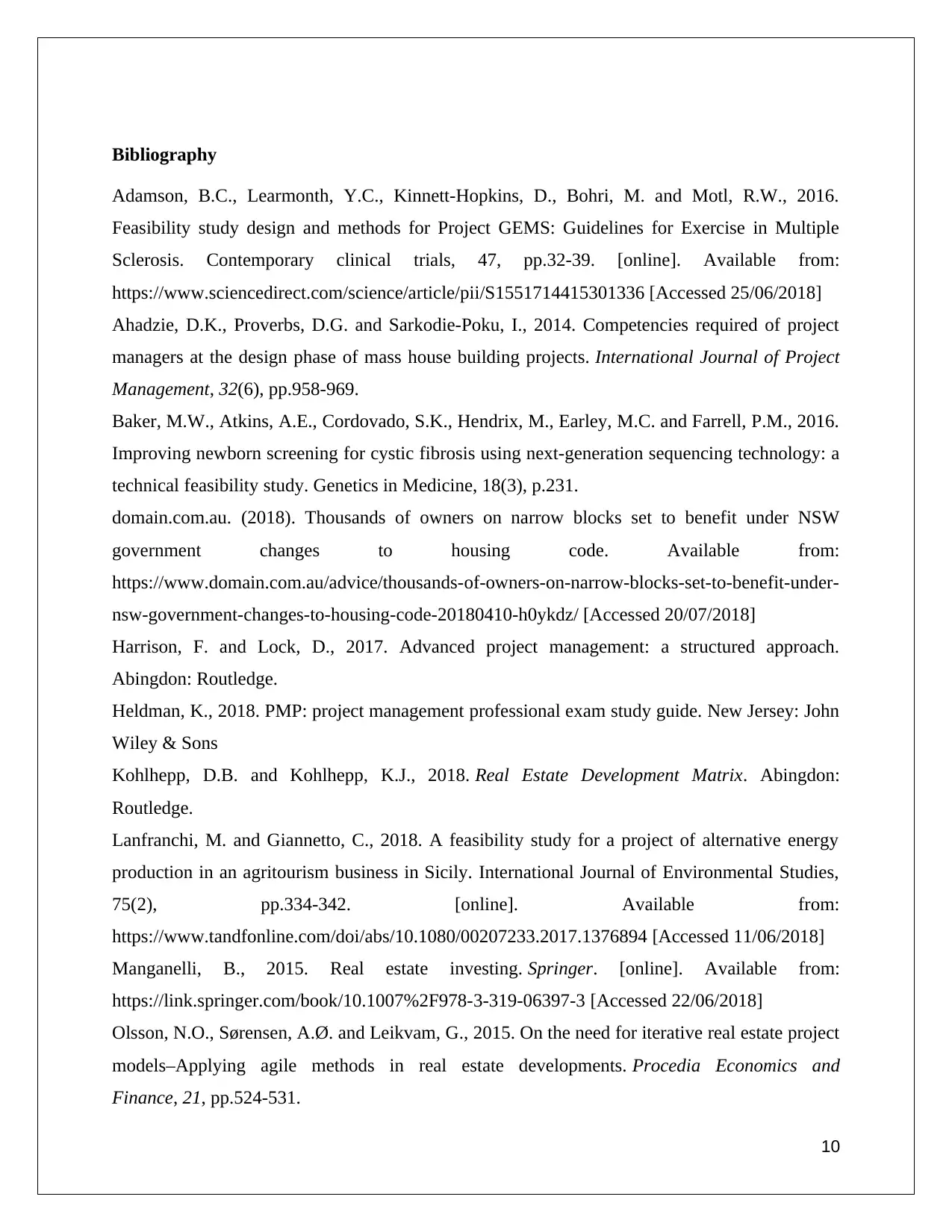
Bibliography
Adamson, B.C., Learmonth, Y.C., Kinnett-Hopkins, D., Bohri, M. and Motl, R.W., 2016.
Feasibility study design and methods for Project GEMS: Guidelines for Exercise in Multiple
Sclerosis. Contemporary clinical trials, 47, pp.32-39. [online]. Available from:
https://www.sciencedirect.com/science/article/pii/S1551714415301336 [Accessed 25/06/2018]
Ahadzie, D.K., Proverbs, D.G. and Sarkodie-Poku, I., 2014. Competencies required of project
managers at the design phase of mass house building projects. International Journal of Project
Management, 32(6), pp.958-969.
Baker, M.W., Atkins, A.E., Cordovado, S.K., Hendrix, M., Earley, M.C. and Farrell, P.M., 2016.
Improving newborn screening for cystic fibrosis using next-generation sequencing technology: a
technical feasibility study. Genetics in Medicine, 18(3), p.231.
domain.com.au. (2018). Thousands of owners on narrow blocks set to benefit under NSW
government changes to housing code. Available from:
https://www.domain.com.au/advice/thousands-of-owners-on-narrow-blocks-set-to-benefit-under-
nsw-government-changes-to-housing-code-20180410-h0ykdz/ [Accessed 20/07/2018]
Harrison, F. and Lock, D., 2017. Advanced project management: a structured approach.
Abingdon: Routledge.
Heldman, K., 2018. PMP: project management professional exam study guide. New Jersey: John
Wiley & Sons
Kohlhepp, D.B. and Kohlhepp, K.J., 2018. Real Estate Development Matrix. Abingdon:
Routledge.
Lanfranchi, M. and Giannetto, C., 2018. A feasibility study for a project of alternative energy
production in an agritourism business in Sicily. International Journal of Environmental Studies,
75(2), pp.334-342. [online]. Available from:
https://www.tandfonline.com/doi/abs/10.1080/00207233.2017.1376894 [Accessed 11/06/2018]
Manganelli, B., 2015. Real estate investing. Springer. [online]. Available from:
https://link.springer.com/book/10.1007%2F978-3-319-06397-3 [Accessed 22/06/2018]
Olsson, N.O., Sørensen, A.Ø. and Leikvam, G., 2015. On the need for iterative real estate project
models–Applying agile methods in real estate developments. Procedia Economics and
Finance, 21, pp.524-531.
10
Adamson, B.C., Learmonth, Y.C., Kinnett-Hopkins, D., Bohri, M. and Motl, R.W., 2016.
Feasibility study design and methods for Project GEMS: Guidelines for Exercise in Multiple
Sclerosis. Contemporary clinical trials, 47, pp.32-39. [online]. Available from:
https://www.sciencedirect.com/science/article/pii/S1551714415301336 [Accessed 25/06/2018]
Ahadzie, D.K., Proverbs, D.G. and Sarkodie-Poku, I., 2014. Competencies required of project
managers at the design phase of mass house building projects. International Journal of Project
Management, 32(6), pp.958-969.
Baker, M.W., Atkins, A.E., Cordovado, S.K., Hendrix, M., Earley, M.C. and Farrell, P.M., 2016.
Improving newborn screening for cystic fibrosis using next-generation sequencing technology: a
technical feasibility study. Genetics in Medicine, 18(3), p.231.
domain.com.au. (2018). Thousands of owners on narrow blocks set to benefit under NSW
government changes to housing code. Available from:
https://www.domain.com.au/advice/thousands-of-owners-on-narrow-blocks-set-to-benefit-under-
nsw-government-changes-to-housing-code-20180410-h0ykdz/ [Accessed 20/07/2018]
Harrison, F. and Lock, D., 2017. Advanced project management: a structured approach.
Abingdon: Routledge.
Heldman, K., 2018. PMP: project management professional exam study guide. New Jersey: John
Wiley & Sons
Kohlhepp, D.B. and Kohlhepp, K.J., 2018. Real Estate Development Matrix. Abingdon:
Routledge.
Lanfranchi, M. and Giannetto, C., 2018. A feasibility study for a project of alternative energy
production in an agritourism business in Sicily. International Journal of Environmental Studies,
75(2), pp.334-342. [online]. Available from:
https://www.tandfonline.com/doi/abs/10.1080/00207233.2017.1376894 [Accessed 11/06/2018]
Manganelli, B., 2015. Real estate investing. Springer. [online]. Available from:
https://link.springer.com/book/10.1007%2F978-3-319-06397-3 [Accessed 22/06/2018]
Olsson, N.O., Sørensen, A.Ø. and Leikvam, G., 2015. On the need for iterative real estate project
models–Applying agile methods in real estate developments. Procedia Economics and
Finance, 21, pp.524-531.
10
Paraphrase This Document
Need a fresh take? Get an instant paraphrase of this document with our AI Paraphraser
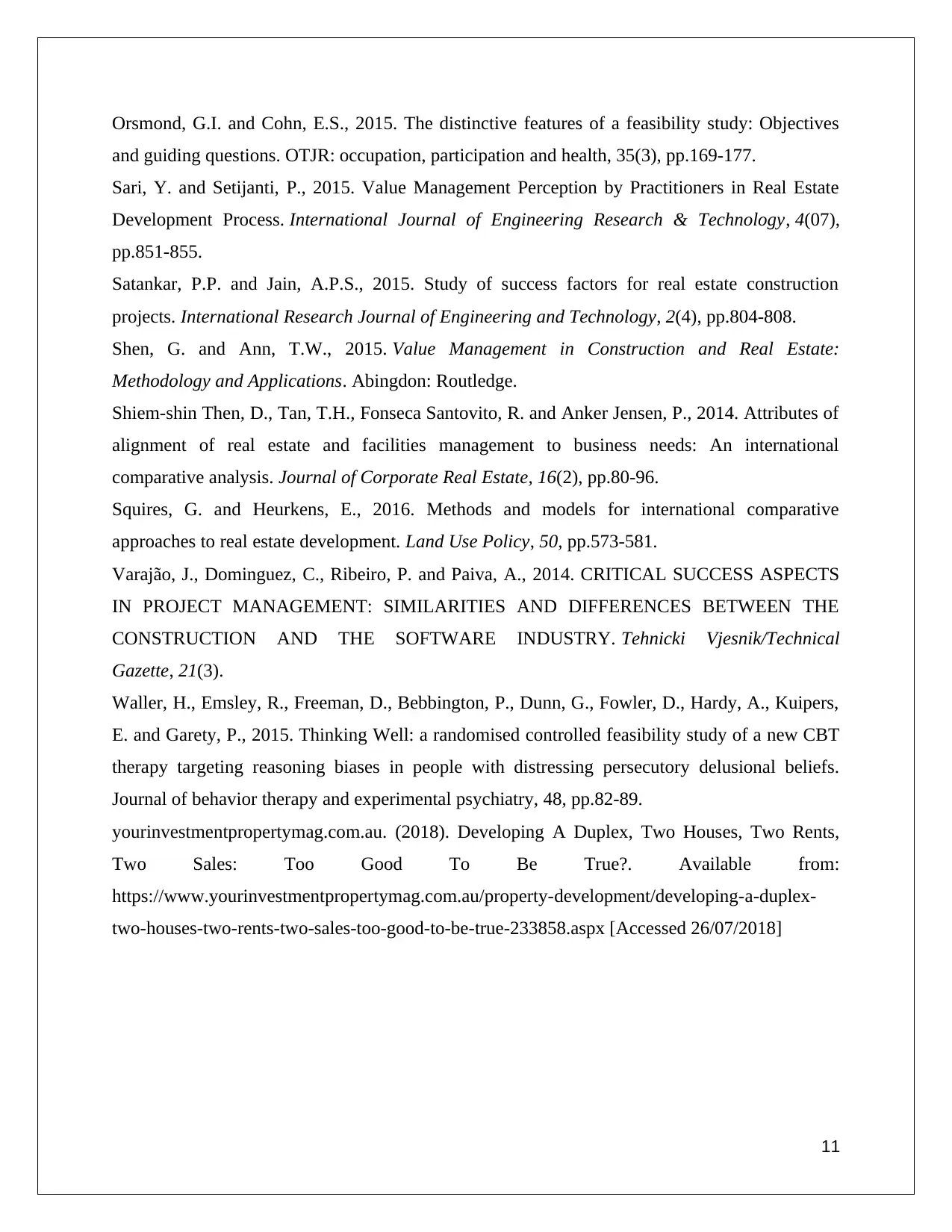
Orsmond, G.I. and Cohn, E.S., 2015. The distinctive features of a feasibility study: Objectives
and guiding questions. OTJR: occupation, participation and health, 35(3), pp.169-177.
Sari, Y. and Setijanti, P., 2015. Value Management Perception by Practitioners in Real Estate
Development Process. International Journal of Engineering Research & Technology, 4(07),
pp.851-855.
Satankar, P.P. and Jain, A.P.S., 2015. Study of success factors for real estate construction
projects. International Research Journal of Engineering and Technology, 2(4), pp.804-808.
Shen, G. and Ann, T.W., 2015. Value Management in Construction and Real Estate:
Methodology and Applications. Abingdon: Routledge.
Shiem-shin Then, D., Tan, T.H., Fonseca Santovito, R. and Anker Jensen, P., 2014. Attributes of
alignment of real estate and facilities management to business needs: An international
comparative analysis. Journal of Corporate Real Estate, 16(2), pp.80-96.
Squires, G. and Heurkens, E., 2016. Methods and models for international comparative
approaches to real estate development. Land Use Policy, 50, pp.573-581.
Varajão, J., Dominguez, C., Ribeiro, P. and Paiva, A., 2014. CRITICAL SUCCESS ASPECTS
IN PROJECT MANAGEMENT: SIMILARITIES AND DIFFERENCES BETWEEN THE
CONSTRUCTION AND THE SOFTWARE INDUSTRY. Tehnicki Vjesnik/Technical
Gazette, 21(3).
Waller, H., Emsley, R., Freeman, D., Bebbington, P., Dunn, G., Fowler, D., Hardy, A., Kuipers,
E. and Garety, P., 2015. Thinking Well: a randomised controlled feasibility study of a new CBT
therapy targeting reasoning biases in people with distressing persecutory delusional beliefs.
Journal of behavior therapy and experimental psychiatry, 48, pp.82-89.
yourinvestmentpropertymag.com.au. (2018). Developing A Duplex, Two Houses, Two Rents,
Two Sales: Too Good To Be True?. Available from:
https://www.yourinvestmentpropertymag.com.au/property-development/developing-a-duplex-
two-houses-two-rents-two-sales-too-good-to-be-true-233858.aspx [Accessed 26/07/2018]
11
and guiding questions. OTJR: occupation, participation and health, 35(3), pp.169-177.
Sari, Y. and Setijanti, P., 2015. Value Management Perception by Practitioners in Real Estate
Development Process. International Journal of Engineering Research & Technology, 4(07),
pp.851-855.
Satankar, P.P. and Jain, A.P.S., 2015. Study of success factors for real estate construction
projects. International Research Journal of Engineering and Technology, 2(4), pp.804-808.
Shen, G. and Ann, T.W., 2015. Value Management in Construction and Real Estate:
Methodology and Applications. Abingdon: Routledge.
Shiem-shin Then, D., Tan, T.H., Fonseca Santovito, R. and Anker Jensen, P., 2014. Attributes of
alignment of real estate and facilities management to business needs: An international
comparative analysis. Journal of Corporate Real Estate, 16(2), pp.80-96.
Squires, G. and Heurkens, E., 2016. Methods and models for international comparative
approaches to real estate development. Land Use Policy, 50, pp.573-581.
Varajão, J., Dominguez, C., Ribeiro, P. and Paiva, A., 2014. CRITICAL SUCCESS ASPECTS
IN PROJECT MANAGEMENT: SIMILARITIES AND DIFFERENCES BETWEEN THE
CONSTRUCTION AND THE SOFTWARE INDUSTRY. Tehnicki Vjesnik/Technical
Gazette, 21(3).
Waller, H., Emsley, R., Freeman, D., Bebbington, P., Dunn, G., Fowler, D., Hardy, A., Kuipers,
E. and Garety, P., 2015. Thinking Well: a randomised controlled feasibility study of a new CBT
therapy targeting reasoning biases in people with distressing persecutory delusional beliefs.
Journal of behavior therapy and experimental psychiatry, 48, pp.82-89.
yourinvestmentpropertymag.com.au. (2018). Developing A Duplex, Two Houses, Two Rents,
Two Sales: Too Good To Be True?. Available from:
https://www.yourinvestmentpropertymag.com.au/property-development/developing-a-duplex-
two-houses-two-rents-two-sales-too-good-to-be-true-233858.aspx [Accessed 26/07/2018]
11
1 out of 11
Related Documents
Your All-in-One AI-Powered Toolkit for Academic Success.
+13062052269
info@desklib.com
Available 24*7 on WhatsApp / Email
![[object Object]](/_next/static/media/star-bottom.7253800d.svg)
Unlock your academic potential
Copyright © 2020–2025 A2Z Services. All Rights Reserved. Developed and managed by ZUCOL.





